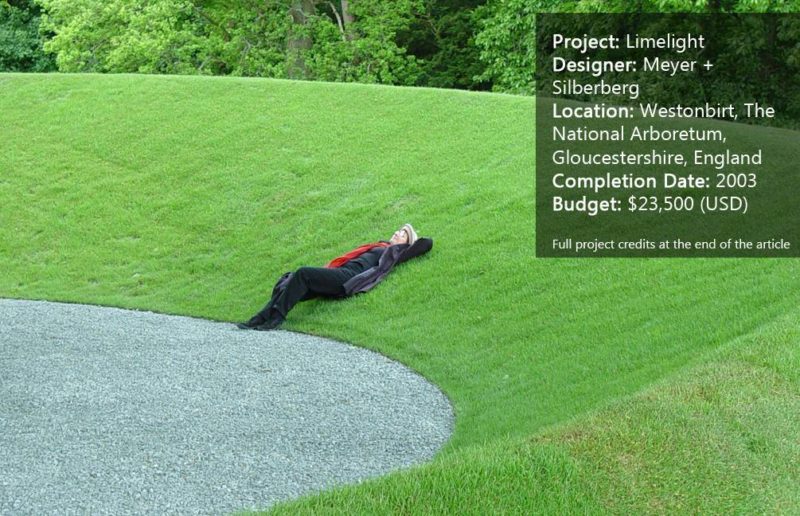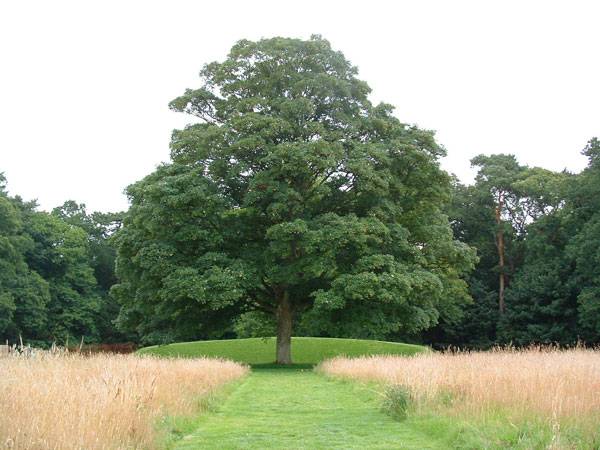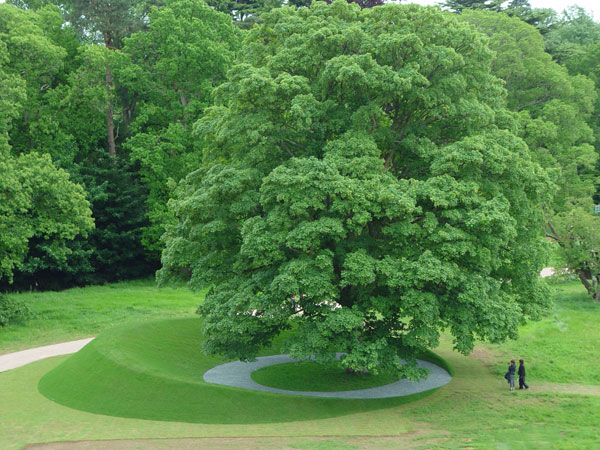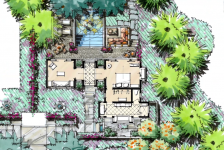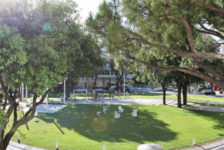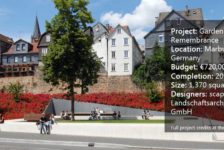Article by Alexis Alvey – A review of the Limelight during Garden Festival, designed by Meyer + Silberberg Land Architects in Westonbirt, The National Arboretum, Gloucestershire, England Limelight, by Meyer + Silberberg Land Architects, is a minimalist garden installation that was created at Westonbirt, The National Arboretum of England, for its 2003 International Festival of Gardens. Although the installation was temporary, Limelight demonstrates how innovative design can be successfully incorporated into a traditional public arboretum, leading to new ways of perceiving the natural landscape.
Putting a Tree in the Limelight At an arboretum, trees take center stage. The Limelight installation pays homage to the centrality of trees in the landscape by elevating their importance on the scale of a single, individual tree. Limelight is a clearly defined earthwork that rises up and encircles a large champion Sycamore Maple (Acer pseudoplatanus) at Westonbirt Arboretum. The sod-covered mound enshrines the tree and also functions as a mini amphitheater where patrons can find respite as they lean back and gaze into the majestic tree’s textured canopy. The mound also separates the tree from the surrounding grove and frames the view of the tree as you walk toward it. As the surrounding grove’s grass was allowed to grow longer during the season, the entrance to and view of the tree as a focal point were emphasized. A simple crushed stone walk enables patrons to walk around the tree and admire it from every angle. Employing few materials, Limelight is an installation that takes advantage of the intersection of landscape architecture and arboriculture to create an effective earthworks formation. The cleanly executed minimalist approach does not distract patrons from the tree, which is clearly the main attraction. Limelight successfully invites visitors to experience the nuances of the numerous, different perspectives of an awe-inspiring tree. The installation utilizes an idealized abstraction of form and is enduring, yet also transferable, since it could just as easily have been created in another arboretum beneath the boughs of another impressive tree.Garden Festival : Westonbirt, The National Arboretum
Limelight was created at Westonbirt Arboretum, which is arguably the most well-known arboretum in the United Kingdom. It is located in Gloucestershire, about three miles southwest of Tetbury. The arboretum dates back to 1829, when it was first established by Robert Stayner Holford, whose family owned Westonbirt House, a large estate on the manor. Using his family fortune, Holford worked with many of the Victorian Age’s leading botanists to oversee an expansive planting program on the property.
The arboretum was designed in the picturesque style, and Holford’s son, George, continued his father’s work in developing the arboretum. The clever use of evergreens as backdrop, the featuring of many rare and exotic trees in their true form, and the skillful pairing of trees for fall color were noted by critics of the time. Passed down through generations, the National Arboretum has been managed by the Forestry Commission since the 1950s. Today, the Friends of the Westonbirt Arboretum work in partnership with the Forestry Commission to help maintain the arboretum as one of the UK’s finest tree collections. Westonbirt boast approximately 15,000 labeled trees. Of these trees, there are at least 145 champion trees –meaning that they are the very largest diameter or tallest specimens of a particular species in all of the British Isles. The official list of champion trees is maintained by The Tree Register of Britain and Ireland.International Festival of the Garden
Various forms of programming at Westonbirt Arboretum have attracted patrons throughout the years. One such program was the International Festival of the Garden, which was inaugurated in the early 2000s and was repeated annually for a few years. Designers, including Meyer + Silberberg Land Architects, were charged with creating installations that responded to the arboretum, its surroundings, and its historical significance.
Garden installations such as Limelight were temporary, and were on exhibit for approximately three to five months. Although no medals were presented, acceptance into the show was by competition and was quite an international honor.Garden Festivals Feature Cutting-Edge Design
Westonbirt’s International Festival of the Garden draws upon Europe’s tradition of competition/demonstration gardens. Most notable and successful is France’s Festival International des Jardins at Chaumont-sur-Loire. These competition garden festivals are essential to the evolution of landscape architecture, because they challenge conventional notions of landscape design and provide a platform for thought and discussion. Having a global influence, garden installations often feature experimental elements related to art, horticulture, and/or architecture.Not surprisingly, these revolving competition gardens require substantial financial, time, and management input, and Westonbirt Arboretum decided to discontinue its festival after a few years. Cornerstone Gardens in Sonoma, California, USA, and Jardins de Métis in Quebec, Canada, are additional examples of garden installations that are currently in operation and successfully showcase cutting-edge design in Cornerstone Gardens in Sonoma, California, USA, and Jardins de Métis in Quebec, Canada, are additional examples of garden installations that are currently in operation and successfully showcase cutting-edge design in landscape.
Studio Profile
Limelight, completed only two years after Meyer + Silberberg Land Architects was founded, granted international recognition to the small studio. Meyer + Silberberg are based out of the Bay Area in Berkeley, California.
Their approach to design is to craft distinct landscapes that knit artistry with technical precision, drawing inspiration from the physical site and surrounding culture. Their goal is to create holistic, beautiful, and enduring spaces that are beloved for generations.Limelight Critique
One important question I have for Meyer + Silberberg is how they came to choose that particular Sycamore Maple (Acer pseudoplatanus) for their Limelight installation. Their response is that it is a champion tree, but the arboretum has more than a hundred other champion trees to choose from. What other factors were involved in the selection process? Was the location of the selected tree in an ideal location? Was the garden festival confined to a certain area of the arboretum? It is surprising that a Sycamore Maple, also commonly known simply as Sycamore, was chosen, since the species is not native to the British Isles and is now naturalized after having been introduced centuries ago from other areas of Europe. In my opinion, a champion Lime tree (Tilia spp.) should have been chosen — a genera of trees that are much more important to the heritage of Britain and that would have worked seamlessly with the title of the installation. Despite this, Limelight demonstrates how design can be successfully incorporated into a traditional public arboretum, leading to new ways for patrons to perceive and appreciate trees within the landscape.
Full Project Credits For Limelight :
Project: Limelight Designer: Meyer + Silberberg Land Architects, Berkeley, California, USA Location: Westonbirt, The National Arboretum, Gloucestershire, England Completion Date: 2003 Budget: $23,500 (USD) Client: Westonbirt International Festival of Gardens Recommended Reading:
- Becoming an Urban Planner: A Guide to Careers in Planning and Urban Design by Michael Bayer
- Sustainable Urbanism: Urban Design With Nature by Douglas Farrs
- eBooks by Landscape Architects Network
Article by Alexis Alvey
Published in Blog


